3D printed buildings became a thing earlier this year, when the first prototype for a working, concrete 3D printer was revealed. Some progress has been done since then, but nothing too major. That's why the new idea from the Institute for Advanced Architecture of Catalonia is bound to have backers.
They've gone the other way. Instead of creating a huge contraption that can make houses in one go, they've invented minibots that can band together and assemble buildings bit by bit.
The robots are, understandably enough, called Minibuilders and are autonomous, though they also have the ability to act as a hive mind, of sorts.
They divide tasks in order to make the construction process not only quick and smooth, but cheaper and less damaging on the environment as well.
You see, the way they go about things will drastically reduce the need for huge bulldozers, tractors and other environment-destroying means of transport. Instead, the Minibuilders will go about their task so long as there is enough fluid construction material.
Here's how everything works: the robots come together in teams that squirt out material which hardens, creating the shell of a building. The robots that make the foundation provide the opening salvo. They move in a track, producing the structure's first 20 layers.
After that come the "grip" robots, which clamp on the top or sides and add more layers, as well as ceilings, window and door frames, etc.
Finally, the vacuum Minibuilders attach to the end and add a final layer that reinforces the whole building when everything else is over and done with.
It's not just the walls that the Minibuilders can produce. In theory, they should be able to create the piping and painting. And if those liquid plastic and graphene 3D printing filaments get the backing they deserve, the electrical wiring should be in the bag too.
In truth, large-scale 3D printing has been around for a few years. Nevertheless, only this year has it begun to rise in profile, like every other 3D printing technology really. The folks at the Spanish Institute for Advanced Architecture of Catalonia will have their work cut out for them in promoting their concept. It's doubtful they'll be dismissed out of hand though.
"The robots can work simultaneously while performing different tasks, and having a fixed size they can create objects of virtually any scale, as far as material properties permit," explain Petr Novikov and Sasa Jokic. "They are extremely easy to transport to the site. All these features make them incredibly efficient and reduce environmental footprint of construction."

 14 DAY TRIAL //
14 DAY TRIAL //